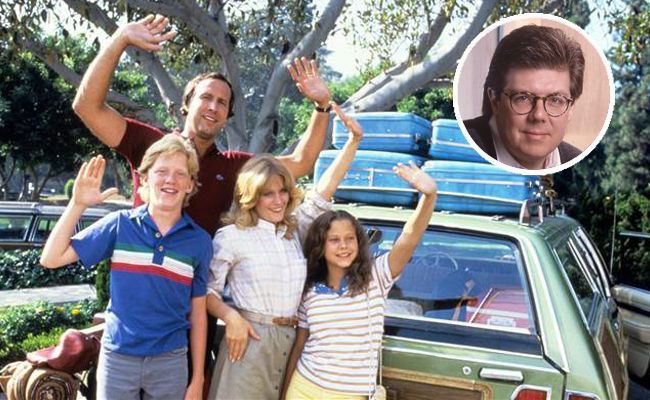
The saga of the Griswold family continues with Vacation‘s release in theaters on Wednesday, a continuation/reboot of the notoriously popular film series starring Ed Helms as Rusty Griswold, now a grown man with a family of his own. Like the first film, it focuses on a family’s road-trip to the Walley World theme park, now on the verge of closing for good.
While the first fateful outing of the Griswolds took theaters by storm in the summer of 1983, screenwriter John Hughes’ first musings about the family’s road trip were found in the pages of National Lampoon magazine back in September of 1979. Titled simply “Vacation, ’58,” it was a wildly embellished account of his own father’s noble, but disastrous attempt to take his family to Disneyland.
Prior to being published, Hughes was working as a creative director for the Leo Burnett Company out of Chicago. During his weekly trips to New York, Hughes would quietly duck out of “multi-martini lunches” (it really was just like Mad Men) to skulk around the offices of National Lampoon, a well-known parody magazine that had already launched a number of successful careers. His aim? Score a writing assignment.
After weeks of being ignored by the “aloof staffers and freelancers,” he ended up meeting with Tony Hendra, the magazine’s editor-in-chief at the time. After some initial assignments were published, Hughes was given the title of contributing editor, which meant he was writing at every available opportunity, even making special arrangements at his day job to do so. It wasn’t until a snow storm trapped him in his Chicago home for three days that Hughes was finally allowed to write without interruption.
It was during that three days that he wrote his pitch for the magazine’s vacation-themed issue, an ode to the era when “toddlers stood on the front seats of cars and parents’ cigarette ashes blew into the faces of the children standing in the back (or hanging out the open rear windows of station wagons).” Basing the story on his own childhood anecdotes while using a Rand McNally Road Atlas to give the story its outline, he wrote the now-infamous opening line, “If Dad hadn’t shot Walt Disney in the leg, it would have been our best vacation ever!”
Using the son, Rusty, as the story’s narrator to cover for his own self-perceived shortcomings, Hughes recalled that writing the rest of the story after that was “automatic.” While it didn’t run until the fall’s “potpourri issue,” which published everything that had slipped through the cracks at that point, its success was instantaneous. Almost immediately after it was published, Warner Bros. bought the movie rights. By then, Hughes had quit Leo Burnett to become a salaried editor under National Lampoons’ new editor-in-chief, P.J. O’Rourke, who had his own storied history with the magazine.
While Hughes was hired to write the screenplay, a number of other changes were made. Namely, re-writing the Disneyland elements into a sound-alike. Walt Disney became Roy Walley, Disneyland became Walley-World, and Mickey Mouse became Morty Moose. At first, director Harold Ramis was supervising Hughes’ rewrites, before he and Chase would take over with their uncredited take on the script after they thought “he’d gone as far as he was going to go.” Ramis would later lament that this is what prompted him to start directing himself, since “he was tired of seeing his scripts ruined by other directors.”
While the first cut was a more-or-less faithful adaption of Hughes’ short story, a significant change was made to the movie’s original ending. Like “Vacation ’58,” the movie had Clark taking the head of the theme park hostage and forcing him to dance for their amusement before eventually being carted off to jail. Test audiences hated it, and Hughes himself was hired back to re-write the ending, which was considerably more upbeat, and, relatively speaking, much more good-natured.
Hughes himself has repeatedly stated that while he preferred his original ending, he credits his re-write for introducing him to John Candy, who played the last-minute addition of Lasky, a Walley World security guard. He’d later say that Candy “would eventually match the coherence of cruelty, sorrow, disappointment, and farce that underpinned ‘Vacation ’58,'” and would go on to appear in seven of Hughes’ films.
On July 29, 1983, the film was released to widespread acclaim and was a certifiable box-office hit. It established Chevy Chase as a draw, while featuring cameos from the likes of Brian Doyle-Murray, James Keach, Jane Krakowski (in her film debut), along with veteran comedian Imogene Coca, and supermodel Christie Brinkley.
For many, success like that seen with National Lampoon’s Vacation would never be glimpsed again, but Hughes would go on to write and direct some of the 1980’s most defining movies, including The Breakfast Club, Weird Science, and Ferris Bueller’s Day Off. Hughes stopped directing after 1991’s Curly Sue, but remained a prolific writer who established both the Home Alone and Beethoven franchises.
Hughes, who passed away at the age of 59 in 2009, also wrote the scripts for the first two sequels, European Vacation and Christmas Vacation. The inspiration for the latter? Another original John Hughes short story, this one entitled Christmas ’59.






